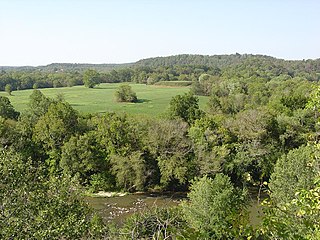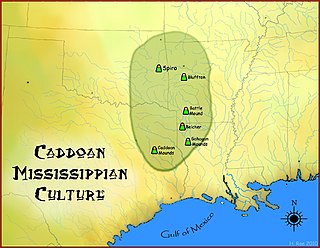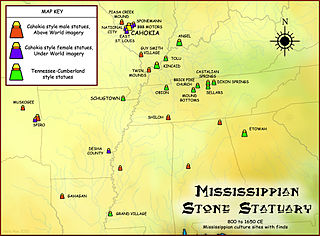
The Duck River Cache was the archaeological discovery of 46 Mississippian culture artifacts by a worker on at the Link Farm Site in Middle Tennessee in December 1894. [1]

The Duck River Cache was the archaeological discovery of 46 Mississippian culture artifacts by a worker on at the Link Farm Site in Middle Tennessee in December 1894. [1]

The cache has been called "perhaps the most spectacular single collection of prehistoric Native American art ever discovered in the eastern United States". [2] "Nearly four dozen ceremonial stone knives, daggers, swords, maces, and other striking examples of prehistoric stonework". [2] The ceremonial objects are made from Dover chert, a type of flint found exclusively in the nearby Dover, Tennessee area. [3]
A few months later in March 1895 the same but slightly deeper location was also the site of the discovery of a paired male and female set of Mississippian sandstone statues nicknamed "Adam" and "Eve". The male statue is now at the Metropolitan Museum of Art and the female statue has been lost. The site is preserved as part of the Johnsonville State Historic Park. [4] [5]
The McClung Museum of Natural History and Culture is a museum located on the campus of the University of Tennessee in Knoxville. Built in 1963, exhibits focus on natural history, archaeology, anthropology, decorative arts, and local history.

Etowah Indian Mounds (9BR1) are a 54-acre (220,000 m2) archaeological site in Bartow County, Georgia south of Cartersville, in the United States. Built and occupied in three phases, from 1000–1550 AD, the prehistoric site is located on the north shore of the Etowah River. Etowah Indian Mounds Historic Site is a designated National Historic Landmark, managed by the Georgia Department of Natural Resources. It is considered "the most intact Mississippian culture site in the Southeastia ", according to the Georgia State Parks and Historic Sites. It is revered as sacred by the Muscogee Creek and Cherokee peoples, who both occupied this area at varying times.

The Mississippian culture was a mound-building Native American civilization that flourished in what is now the Midwestern, Eastern, and Southeastern United States from approximately 800 CE to 1600 CE, varying regionally. It was composed of a series of urban settlements and satellite villages (suburbs) linked together by loose trading networks. The largest city was Cahokia, believed to be a major religious center.

The various cultures collectively termed "Mound Builders" were prehistoric, indigenous inhabitants of North America who, during a 5,000-year period, constructed various styles of earthen mounds for religious, ceremonial, burial, and elite residential purposes. These included the pre-Columbian cultures of the Archaic period, Woodland period, and Mississippian period; dating from roughly 3500 BCE to the 16th century CE, and living in regions of the Great Lakes, the Ohio River Valley, and the Mississippi River valley and its tributary waters.

The Winterville Site is a major archaeological site in unincorporated Washington County, Mississippi, north of Greenville. It consists of major earthwork monuments, including more than twelve large platform mounds and cleared and filled plazas. It is the type site for the Winterville Phase of the Lower Yazoo Basin region of the Plaquemine Mississippian culture. Protected as a state park, it has been designated as a National Historic Landmark. In June 2015 the state authorized $300,000 to restore the mounds to their pre-Columbian condition and add walking trails to the park. The site also includes a museum.

Mound Bottom is a prehistoric Native American complex in Cheatham County, Tennessee, located in the Southeastern United States. The complex, which consists of earthen platform and burial mounds, a 7-acre central plaza, and habitation areas, was occupied between approximately 1000 and 1300 AD, during the Mississippian period.

Sellars Farm Site (40WI1), also known as the Sellars Farm State Archaeological Area and Sellars Indian Mound, is a Mississippian culture archaeological site located in Wilson County, Tennessee near Lebanon. The platform mound was the site of a settlement from about 1000 to 1300 CE. Today, the site is a satellite unit of Long Hunter State Park. The non-profit Friends of the Sellars Farm State Archaeological Area organization conducts tours and upkeep of the site. It was listed on the National Register of Historic Places on December 11, 1972.

The Caddoan Mississippian culture was a prehistoric Native American culture considered by archaeologists as a variant of the Mississippian culture. The Caddoan Mississippians covered a large territory, including what is now Eastern Oklahoma, Western Arkansas, Northeast Texas, and Northwest Louisiana. Archaeological evidence that the cultural continuity is unbroken from prehistory to the present; that the direct ancestors of the modern Caddo Nation of Oklahoma included the speakers of the Caddo and related Caddo language in prehistoric times and at first European contact, is unquestioned today.

The Gahagan Mounds Site (16RR1) is an Early Caddoan Mississippian culture archaeological site in Red River Parish, Louisiana. It is located in the Red River Valley. The site is famous for the three shaft burials and exotic grave goods excavated there in the early twentieth century.

The Mississippian stone statuary are artifacts of polished stone in the shape of human figurines made by members of the Mississippian culture and found in archaeological sites in the American Midwest and Southeast. Two distinct styles exist; the first is a style of carved flint clay found over a wide geographical area but believed to be from the American Bottom area and manufactured at the Cahokia site specifically; the second is a variety of carved and polished locally available stone primarily found in the Tennessee-Cumberland region and northern Georgia. Early European explorers reported seeing stone and wooden statues in native temples, but the first documented modern discovery was made in 1790 in Kentucky, and given as a gift to Thomas Jefferson.

The Tolu Site is a prehistoric archeological site of the Mississippian culture near the unincorporated community of Tolu, Crittenden County, Kentucky, United States. It was built and occupied between 1200-1450 CE. No carbon dating has been performed at the site, but analysis of pottery styles suggest its major habitation period was 1200 to 1300 CE. The site originally had three mounds, a burial mound, a substructure platform mound and one other of undetermined function. It was excavated in 1930 by W.S. Webb and William D. Funkhouser.

Obion Mounds, also known as the Work Farm Site, is an archaeological site of the Mississippian culture located north of Paris, Henry County, Tennessee, on the north fork of the Obion River. The site is the largest Mississippian site in western Tennessee and was probably inhabited by 1000 to 1100 CE. and abandoned by 1300. It consists of seven platform mounds surrounding a plaza measuring 200 feet (61 m) by 900 feet (270 m). The largest mound at the site was 500 feet (150 m) wide by 30 feet (9.1 m) tall with a ramp leading to its summit. At one point the mounds and plaza were surrounded with a wooden palisade. The site also has 2 depressions thought to be borrow pits from which the soil to construct the mounds was taken. In 1845 the owner of the site, Solomon Hartsfield, was digging in one of the borrow pits when he discovered a stone statue. The statue was later damaged in a house fire during the late 19th century and only its head now remains. It is the only Mississippian site in western Tennessee to have produced such a statue. Similar statues have been found at the Angel Mounds site near Evansville, Indiana and the Ware Mounds site in Union County, Illinois.

Mill Creek chert is a type of chert found in Southern Illinois and heavily exploited by members of the Mississippian culture. Artifacts made from this material are found in archaeological sites throughout the American Midwest and Southeast. It is named for a village and stream near the quarries, Mill Creek, Illinois and Mill Creek, a tributary of the Cache River. The chert was used extensively for the production of utilitarian tools such as hoes and spades, and for polished ceremonial objects such as bifaces, spatulate celts and maces.

The Castalian Springs Mound State Historic Site (40SU14) is a Mississippian culture archaeological site located near the small unincorporated community of Castalian Springs in Sumner County, Tennessee. The site was first excavated in the 1890s and again as recently as the 2005 to 2011 archaeological field school led by Dr. Kevin E. Smith. A number of important finds have been associated with the site, most particularly several examples of Mississippian stone statuary and the Castalian Springs shell gorget held by the National Museum of the American Indian. The site is owned by the State of Tennessee and is a State Historic Site managed by the Bledsoe's Lick Association for the Tennessee Historical Commission. The site is not currently open to the public.

The Beasley Mounds Site (40SM43) is a Mississippian culture archaeological site located at the confluence of Dixon Creek and the Cumberland River near the unincorporated community of Dixon Springs in Smith County, Tennessee. The site was first excavated by amateur archaeologists in the 1890s. More examples of Mississippian stone statuary have been found at the site than any other in the Middle Tennessee area. The site was listed on the National Register of Historic Places in 2010.

The Brick Church Mound and Village Site (40DV39) is a Mississippian culture archaeological site located in Nashville in Davidson County, Tennessee. It was excavated in the late nineteenth century by Frederic Ward Putnam. During excavations in the early 1970s the site produced a unique cache of ceramic figurines very similar in style to Mississippian stone statuary which are now on display at the Frank H. McClung Museum. It was added to the National Register of Historic Places (NRHP) on May 7, 1973 as NRIS number 73001759 although this did not save the site from being almost totally destroyed by residential development.

Stone box graves were a method of burial employed by Native Americans of the Mississippian culture in the American Midwest and Southeast. Their construction was especially common in the Cumberland River Basin around Nashville, Tennessee

The Link Farm State Archaeological Area, also known as the Duck River Temple Mounds or Duck River Site, is a Mississippian culture archaeological site located at the confluence of the Duck and Buffalo Rivers south of Waverly in Humphreys County, Tennessee. The site is most widely known for the stone artifacts found during excavations in the late 19th century.
| This article relating to archaeology in the United States is a stub. You can help Wikipedia by expanding it. |